Predictive Maintenance Automotive & Auto Preventive Maintenance: Complete Guide
Predictive maintenance automotive — a still fresh concept among car enthusiasts, but true vehicle lovers know for sure that there is no better cure than prevention. And here comes auto preventive maintenance going hand in hand with predictive. But what does it mean for the automotive industry overall, and what should drivers be prepared for?
Experienced car owners know it better than anyone. You find out about the car failing in the middle of the road, rushing to the most critical meeting ever. Or when you see your rear wheel running in front of your car. May sound a little funny, but not for the drivers putting all of their effort and time into that sustained vehicle. Fortunately, more and more dealerships are adopting predictive maintenance automotive technologies and offering vehicles that will alert you to engine failure before you even start hearing those strange noises from within. Moreover, auto preventive maintenance will ensure you never get to the stage of hearing those "expensive sounds". In this guide to predictive maintenance in automotive industry, devabit experts have gathered top insights of successful AI for predictive maintenance implementation, examples, benefits, and pitfalls. Read below to learn how to secure your vehicle and automotivetoive software development investments.
In short, today we will cover the following topics:
- What is predictive maintenance automotive?
- Predictive maintenance automotive is a modern vehicle care strategy that uses real-time data, sensors, and artificial intelligence techniques to predict when a car component is likely to fail. Instead of relying only on fixed service intervals or waiting until something breaks, predictive systems analyze information from the vehicle to prevent potential issues beforehand.
- What is the difference between predictive and preventive maintenance?
- In short, the vital difference between predictive and preventive maintenance lies in preventive technologies relying on regular vehicle checks and repairs, while predictive ones are based on the vehicle data, sensors, and AI algorithms.
- The global automotive industry was valued at around $3.6 trillion in 2023 and is projected to grow to $6.9 trillion by 2033.
- How do condition-based monitoring and predictive maintenance differ?
- Here are a few crucial differences to help us tell condition-based monitoring and predictive maintenance apart: CBM (condition-based monitoring) analyzes the current state of the vehicle and notifies the driver about its failure ex post facto. At the same time, predictive maintenance analyzes the current state of the vehicle to make data-driven predictions about the potential vehicle failures and help the driver or the mechanic prevent them.
- devabit has combined the best of predictive maintenance automotive technologies, agentic AI, and next-gen slot booking approaches in order to build from scratch a dynamic pricing capacity and management platform for leading dealerships, benefiting both the clients and dealership admins.
- Software-defined vehicles and predictive maintenance systems are among the latest innovations, turning cars into connected platforms and reshaping how automakers earn revenue.
- The latest trends in the predictive maintenance automotive industry include:
- Digital Twin + Hybrid Modeling for Component Prediction;
- Multi-Modal Sensors & Acoustic / Vibration Fusion;
- Generative AI & Conversational Interfaces over Maintenance Data.
Go right below to find more ground-breaking predictive maintenance automotive insights:
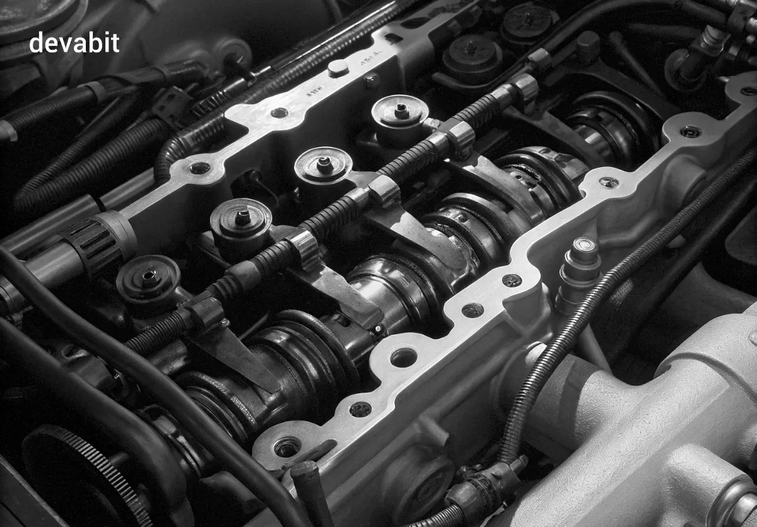
- Predictive Maintenance Automotive: Facts and Stats
- What is predictive maintenance for cars, and how does it work?
- How does AI for predictive maintenance differ from standard condition-based monitoring?
- What’s the difference between auto preventive maintenance and predictive maintenance?
- What are examples of preventive and predictive maintenance in automotive industry?
- How can predictive maintenance be integrated into dealership management systems (DMS)?
- Can my dealership management system remind me about predictive maintenance for my car?
- Do dealerships use AI to track when my vehicle will need preventive or predictive maintenance?
- What are the latest trends in predictive maintenance for automotive manufacturing?
- Predictive Maintenance Automotive: devabit Predicts...
Predictive Maintenance Automotive: Facts and Stats
Before your vehicle hits the road, it goes through a far longer path than your way to the local dealership. From an initial concept and digital prototype to quality control and distribution itself. In 2025, automakers are shifting from pure manufacturing to software-driven mobility providers, offering connected services, predictive maintenance, and even subscription-based features. Meaning that we have entered the era of smart vehicles like the sharpest turn, and if the company misses it, good luck winning the race.
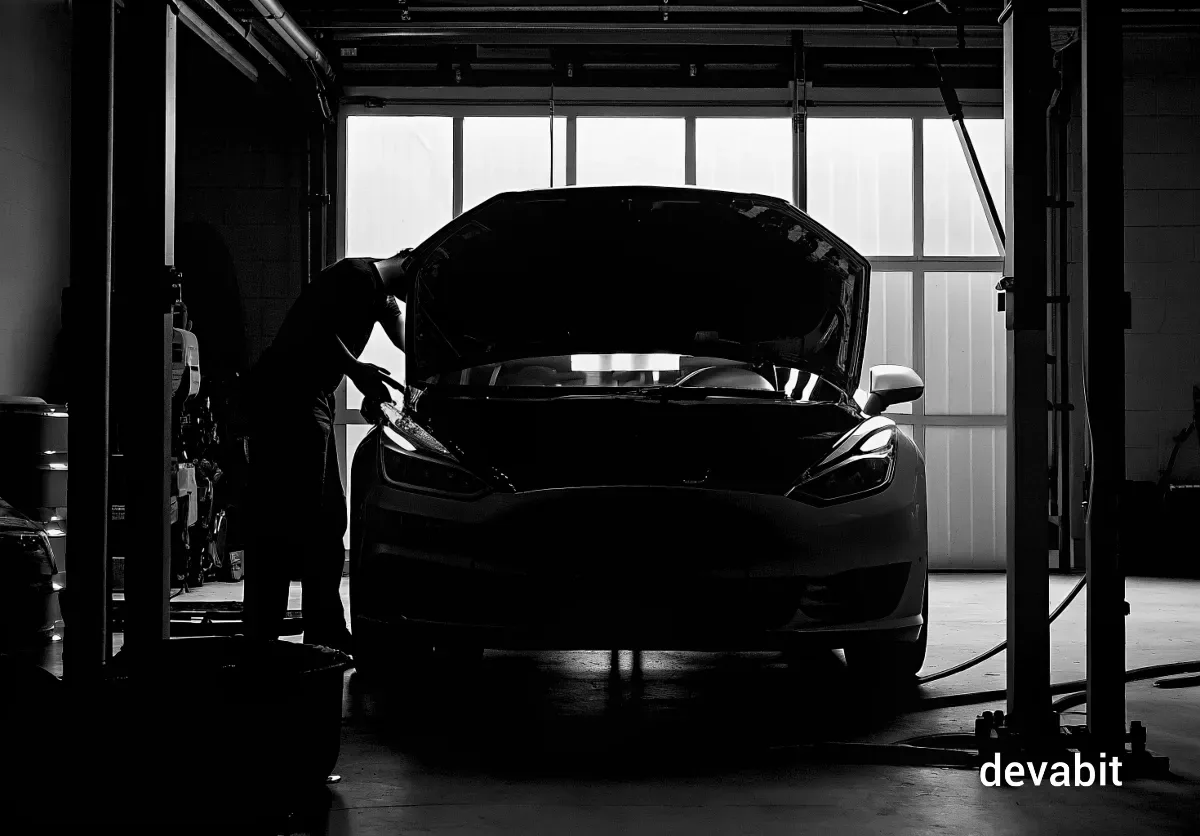
So, before hitting the gas, it is safe to say we need our seatbelts on and headlights checked. Let's have a look at a few automotive facts and statistics to help us understand the industry's journey to predictive and preventive maintenance becoming an ordinary thing. The latest automotive industry statistics project:
- The global automotive industry is expected to reach about USD 6.9 trillion by 2033, demonstrating a CAGR of ~6.8 %.
Why? — Electrification or Electric Vehicle adoption, along with the expansion of connected and predictive services, is going hand in hand with urbanization.
- China accounts for the largest share of vehicle sales globally.
Why? — Massive domestic demand and export demand growth on the one hand, and one of the most sustainable conscious automotive production on the other.
- The global autonomous car market was valued at over $ 41 billion in 2024 and is expected to grow in the following years.
Why? — The US is still keeping the bar at a high level in terms of AI in the automotive industry, advanced self-driving systems, and machine learning algorithms, making it challenging to actually compete with.
- Predictive maintenance (PdM) cuts unplanned downtime by up to ~50% and maintenance costs by 10-40% when properly implemented.
Why? — Let's talk about it right below :)
Seeing you on our page is such a pleasure! And we assume you are the one interested in the latest automotive innovations. So are we! And how about diving a little deeper into the world of automotive AI, the latest industry trends, stats, and facts?
Especially for such cases, our team has prepared an ultimate guide to the use of AI in the automotive industry in simple terms. Meet the most relevant statistics, thrilling automotive software development facts, and shocking innovations right here:
What Is Predictive Maintenance for Cars, and How Does It Work?
Simply put, predictive maintenance (PdM) automotive is an advanced approach to vehicle care that goes beyond traditional check-ups and scheduled servicing. Instead of waiting for parts to fail or replacing them on a fixed timeline, predictive maintenance uses real-time data, intelligent analytics, or even AI algorithms to forecast when a component is likely to break down. This approach gives drivers and fleet operators the chance to fix issues before they cause breakdowns, costly repairs, or safety risks. Sounds like something your friend with tarot cards would tell you, but let us line it up for you.
The way it works is straightforward but powerful. Modern cars are equipped with dozens of sensors and onboard diagnostic systems that constantly monitor such characteristics as temperature, vibration, fluid levels, and electronic signals. That data is permanently collected and analyzed, often with the help of AI algorithms, machine learning, and telematics platforms.
When patterns in the data suggest that a part, such as a battery, brake system, or engine component, is showing signs of wear, the predictive maintenance system triggers an alert. This early warning allows maintenance to be scheduled during planned downtime rather than after an unexpected failure, saving not only your time but most importantly costs and hassles.
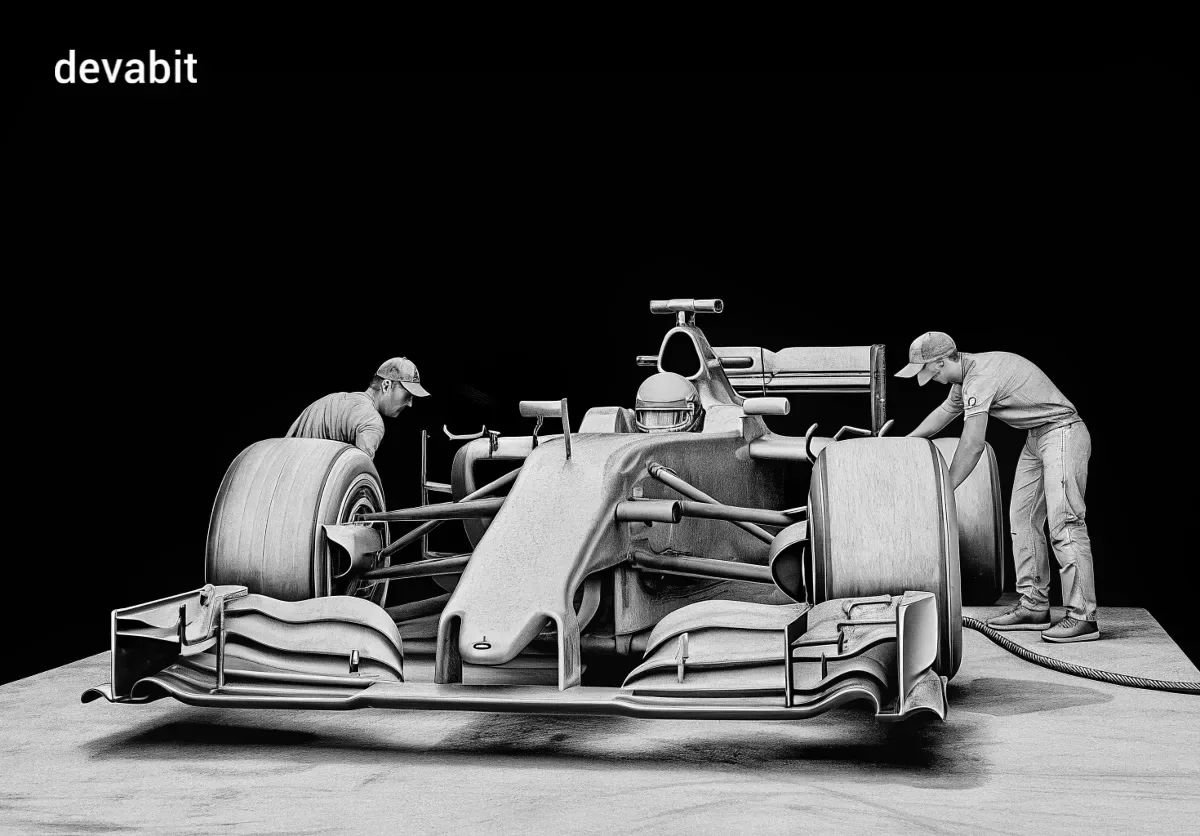
How Does AI for Predictive Maintenance Differ from Standard Condition-Based Monitoring?
Even though predictive maintenance automotive is a quite fresh concept floating around the car fans, you might have heard of something called "condition-based monitoring". Despite the fact that these two concepts stand really close to each other, there are a few key differences we must consider, like:
- Data Depth & Intelligence: while condition-based monitoring tracks the current state of the vehicle and notifies the driver about the damage ex post facto, automotive predictive maintenance utilizes advanced algorithms to analyze your vehicle data and actually predict and, most importantly, prevent the failure.
- Proactive vs. Reactive Alerts: in simple terms, condition-based monitoring will let you know about the low battery level when your vehicle hits the 10% mark, while predictive maintenance automotive will ensure you know about the low battery risk beforehand, and even will take actions to prevent an unexpected battery fail if the car is equipped with the machine learning algorithms.
- Integration of Multiple Data Sources: condition-based monitoring and predictive maintenance technology both work with the vehicle data, but in quite different ways. Traditional monitoring usually works in isolation: one sensor, one metric. Predictive maintenance combines telematics, driving behavior, historical repair records, and even external conditions like weather or road type, making the predictions accurate and actions justified.
Summing up, predictive maintenance automotive is the upgraded version of condition-based monitoring. Smarter, better, safer, and more trustworthy.
What’s the Difference Between Auto Preventive Maintenance and Predictive Maintenance?
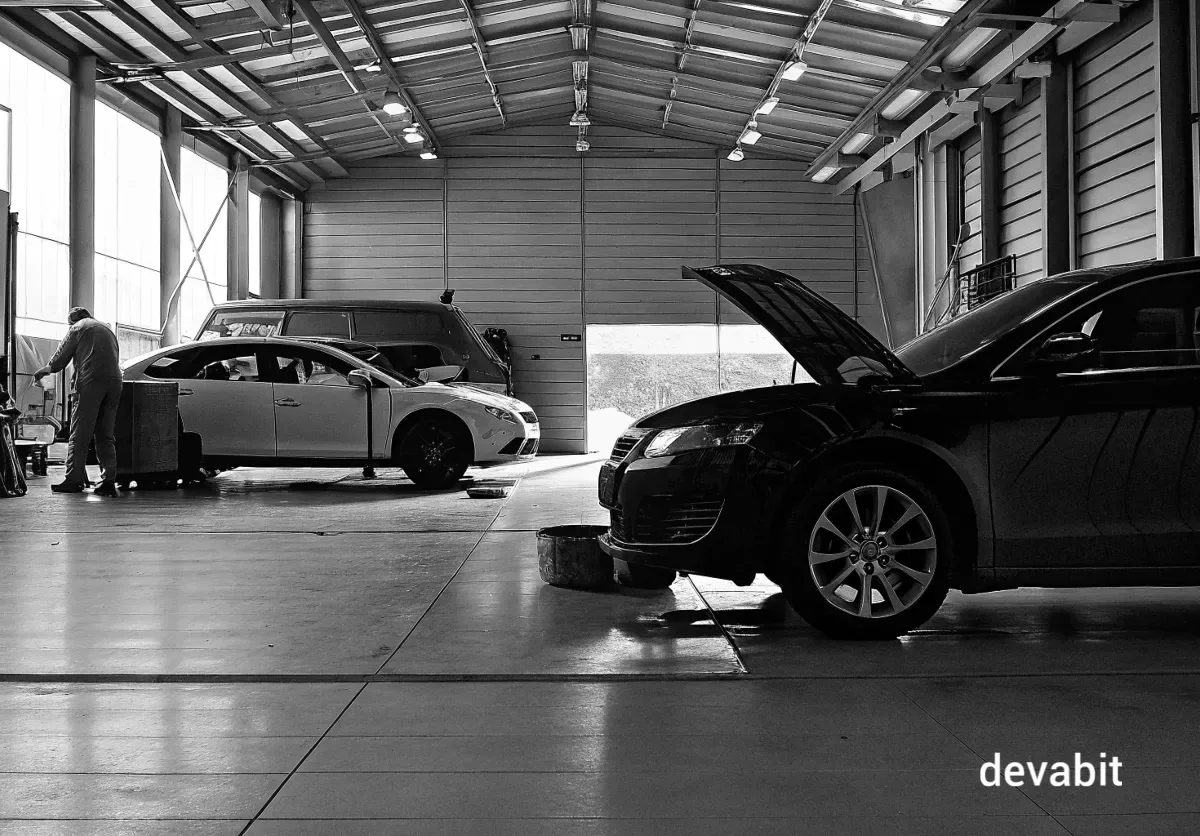
Now that we have investigated the predictive maintenance and condition-based monitoring gap, it is time to take a look at preventive maintenance.
Concepts so close that it is sometimes challenging to notice the difference at first sight, but we are here to reveal it all for you. The key disparities between preventive and predictive maintenance automotive include:
- Scheduling vs. Data-Driven Insights: preventive maintenance relies on fixed schedules or mileage intervals, like changing engine oil every 10,000 km or rotating tires every six months. Predictive maintenance, however, uses real-time sensor data and AI analytics to decide the right moment for service. This means parts are neither replaced too early nor too late.
- Efficiency and Cost Control: because preventive maintenance follows a checklist, it can sometimes lead to over-servicing, replacing components that still have plenty of useful life left. In contrast, predictive maintenance minimizes waste by servicing only when the system detects early signs of wear, cutting overall costs and extending component lifespan.
- Risk Management: preventive maintenance reduces the probability of breakdowns, but can still miss sudden failures that happen between service intervals. Predictive maintenance closes this gap by providing early warnings based on the vehicle data, helping avoid unplanned downtime and costly roadside incidents.
All new is well forgotten past, and, roughly speaking, preventive maintenance has transformed from regular check-ups at your buddy mechanic to your car recommending you to check the gears out of the schedule because of a strange activity spotted.
What Are Examples of Preventive and Predictive Maintenance in Automotive Industry?
Moving straight to the most scrumptious part. In case predictive maintenance automotive still seems a vague alley, we've got your back. Let's have a look at an exclusive example of predictive maintenance in automotive industry, bringing maximum value for both drivers and dealerships.
What is the key concept behind the project?
For creating our dynamic pricing and capacity management platform for the dealerships distributing the leaders of the automotive world, devabit experts have combined the pure cream of AI-driven technology: predictive maintenance, agentic artificial intelligence, and DMS systems. In a nutshell, the platform is designed to effortlessly fulfill such needs as:
- Identify the potential vehicle failures via predictive maintenance;
- Notify the driver and the dealership center about the potential break beforehand, using the pre-collected and analyzed vehicle data;
- Find and offer the perfect-fit booking slots for the driver to assign the next vehicle check or a repair session via the agentic AI algorithms;
- Promote the less popular booking slots for the clients, making them cheaper and more convenient, while ensuring the dealership has zero downtime and all the drivers always have a free booking spot for their needs.
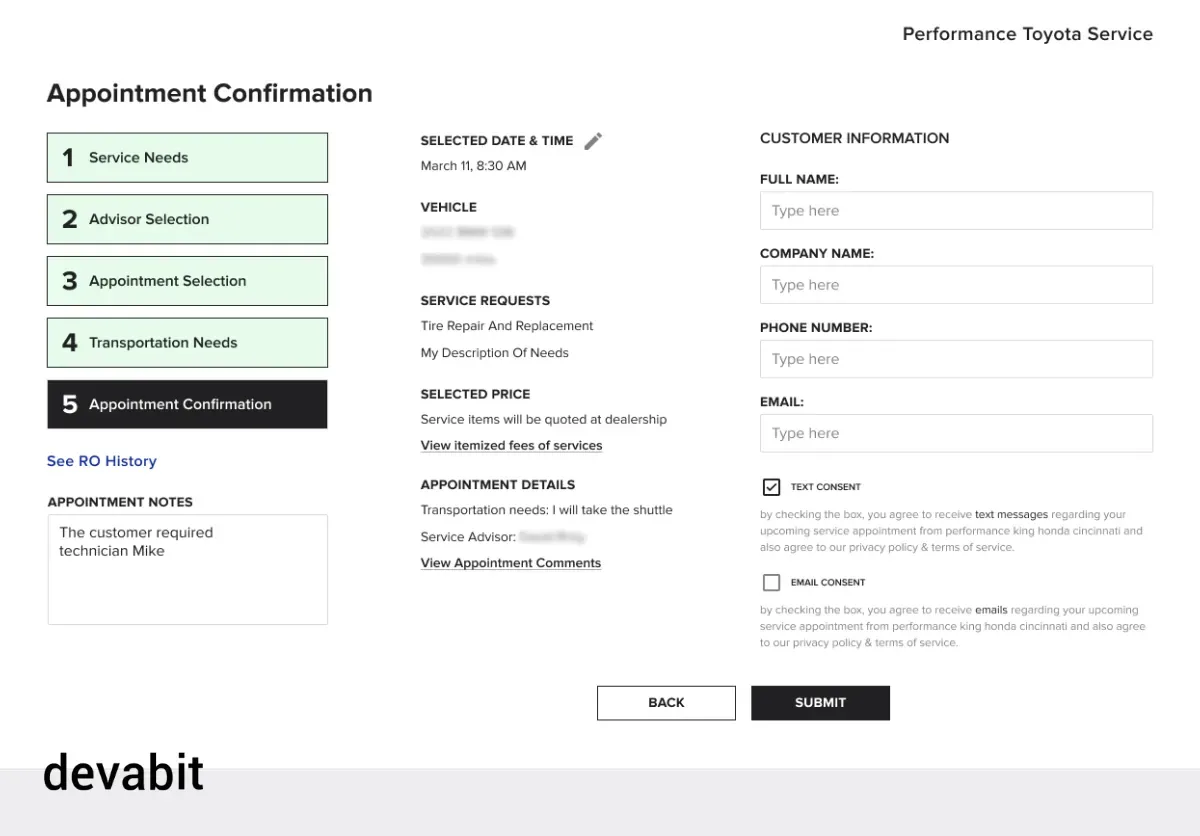
How is predictive maintenance automotive involved in the project?
In fact, automotive predictive maintenance is the cornerstone of our project, making vehicle maintenance effortless for both drivers and mechanics. Within our dynamic platform, we use V2V (Vehicle to Vehicle) or a connected vehicle technology to gather, store, analyze, and utilize the most diverse vehicle data for making only data-driven decisions and predictions, directly influencing the way driver sees their car.
While the predictive maintenance technology monitors your vehicle, the agentic AI algorithms on the platform are already analyzing the data and preparing a notification of a recommended mechanism check, along with a perfect-fit time slot based on your previous visits, personal preferences, and issue type.
This way, our client has all of their time slots permanently filled, even the most undemanded ones, and the drivers never have to face the urge of an unexpected system failure with no experts available at the time.
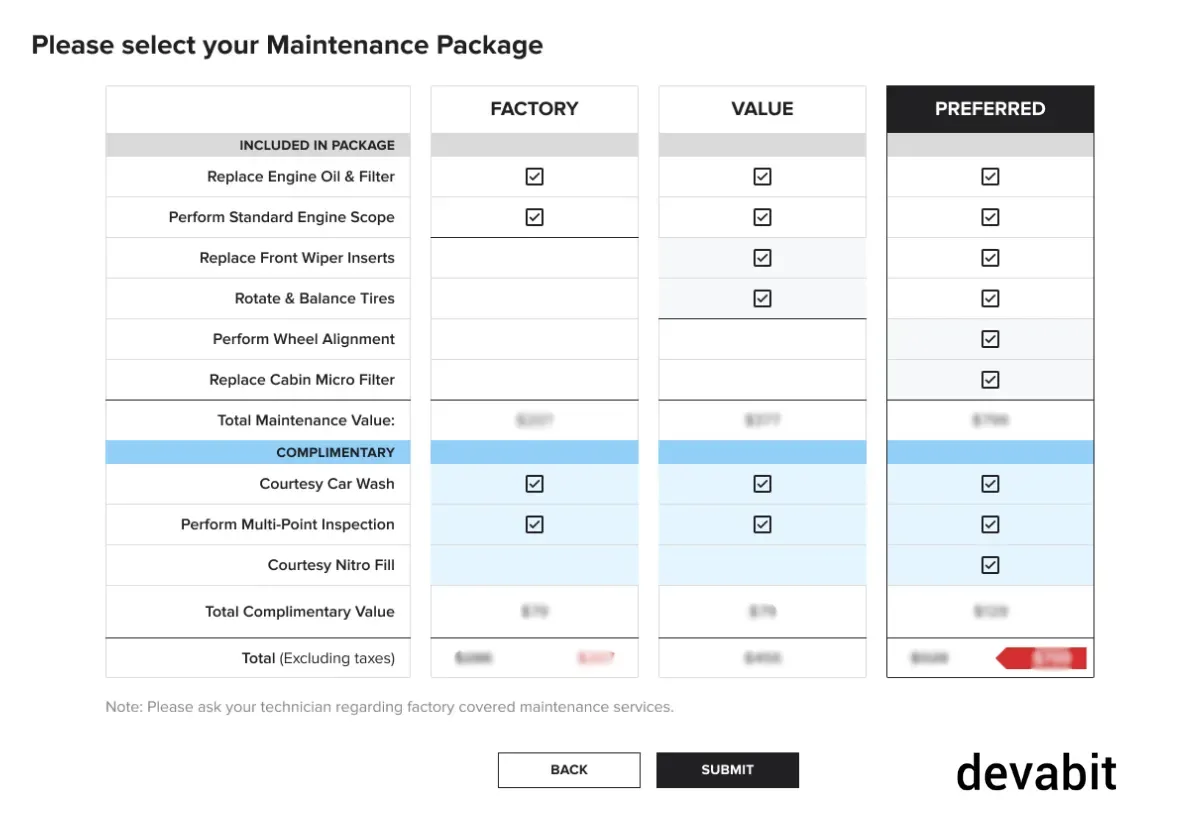
What data does the predictive maintenance technology analyze within the platform?
In order to have a complete picture of your vehicle's state, the platform analyzes such data as:
- The VIN Code Data, like vehicle manufacturer, model, year of manufacture, serial number, and vehicle history. This information is especially helpful for the algorithms to understand when your car was last checked or involved in an accident. This data enables the platform to make informed decisions about the necessity of a vehicle check and the potential repair type.
- Real-Time Sensor Inputs include information on engine performance, oil quality, coolant temperature, fuel system pressure, brake wear, tire pressure, and battery health. By continuously monitoring these parameters, the predictive maintenance system can identify subtle irregularities that often go unnoticed by drivers and actually prevent them.
- Telematics and Driving Behavior Data. The platform evaluates mileage, average speed, driving style (such as harsh braking or rapid acceleration), and even environmental factors like road conditions or weather. These variables help the predictive maintenance automotive model adjust predictions for each individual vehicle rather than relying on generic averages.
- Visit Records. Anything from the date and time you last visited the dealership center to all of the manipulations conducted with your vehicle, and experts' notes about the vehicle's state. Everything to make your next visit as comfortable and harmless as possible.
Everybody knows that feeling of taking that last turn to your apartment after a long day, knowing that the warm bed awaits you, and your car deserves some rest after being so unmistakable today. The platform users know for sure what it is like to never have that oil change headache or a battery fail in the middle of nowhere nightmare.
Our experts managed to not only reassure hundreds of drivers on the roads but also bring significant savings and profits to the client, expecting us to build a solid booking platform, but received so much more at the end of our trip.
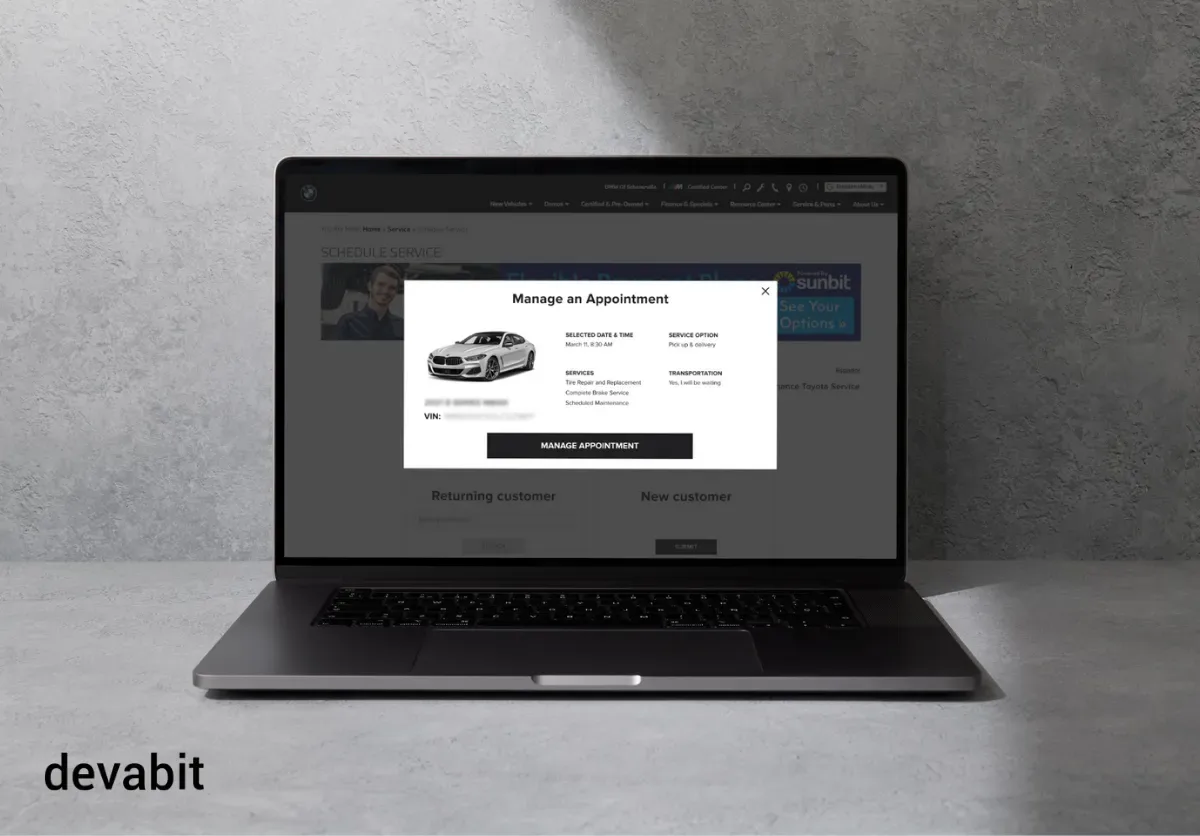
Let's now take a moment to answer a few popular frequently asked questions we kept getting while developing the solution.
How Can Predictive Maintenance Be Integrated into Dealership Management Systems (DMS)?
The integration starts with data connectivity. Modern vehicles equipped with telematics and onboard diagnostics send real-time vehicle data (engine codes, battery status, brake wear, mileage, etc.) directly to the dealership’s platform. The DMS predictive maintenance system analyzes this information and uses predictive algorithms to determine when a vehicle is likely to require a maintenance session.
Once analyzed, the agentic system can automatically generate service reminders, notify service advisors, or even schedule appointments on behalf of the customer. This not only improves vehicle uptime but also fosters customer trust by demonstrating that the dealership can resolve issues before they arise. Finally, integration benefits sales and customer loyalty.
Dealerships can provide personalized service plans, demonstrate transparency in vehicle health reports, and position themselves as partners in long-term vehicle care. This predictive maintenance approach creates new revenue possibilities and boosts client loyalty.
Can My Dealership Management System Remind Me About Predictive Maintenance for My Car?
Absolutely! That is the primary function of our dynamic platform, built to enable the drivers to always be aware of their vehicle's state. Our agentic AI systems send alertive push notifications about the potential threat, and while you read it, the AI agent is already busy choosing the best-fit time slot for your next visit. The platform is compatible with both mobile and desktop gadgets, working perfectly for both iOS and Android.
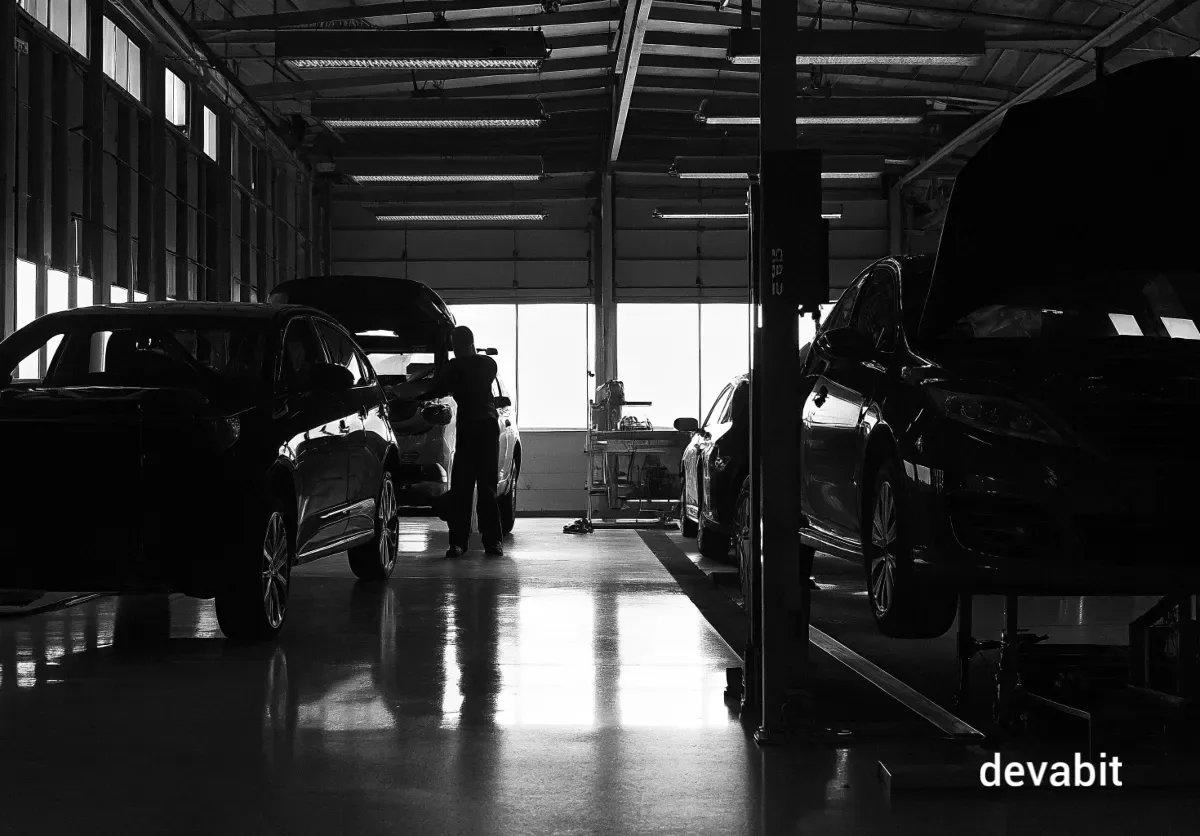
Do Dealerships Use AI to Track When My Vehicle Will Need Preventive or Predictive Maintenance?
Not all of the dealerships utilize artificial intelligence technologies to track, analyze, and predict, but our definitely does. Our custom-built project combines the benefits of agentic AI algorithms to autonomously collect, analyze, process, and produce vehicle data for making informed decisions, predictions, and even taking actions such as sending a notification or finding a perfect visit slot.
Our leading automotive client is not ready to limit the solution to the agentic technologies and actively involves devabit experts for crafting tailored strategies for further broadening of AI features.
New to the Agentic AI in the automotive industry concept? We've got you! Below, we have gathered four exclusive examples of the automotive Agentic AI, and answered the most frequently asked questions in plain English. Follow the link to find out:
- What is Agentic AI, and how does it differ from regular AI?
- What makes Agentic AI "agentic"?
- How does Agentic AI work?
- What are the key benefits and pitfalls of the Agentic AI?
- How do you build a secure Agentic AI software?
Do not miss your opportunity to be the winner of the automotive AI race!
What Are the Latest Trends in Predictive Maintenance for Automotive Manufacturing?
While predictive maintenance automotive is considered to be one of the latest trends in the world of vehicle care itself, there are a few emerging trends you should take a look at:
01 / Digital Twin + Hybrid Modeling for Component Prediction
Implementing 3D modeling techniques that help dealerships and manufacturers permanently test the vehicle state under specific conditions in order to improve predictive algorithms and have a broader understanding of how a specific car would act in a certain environment.
02 / Multi-Modal Sensors & Acoustic / Vibration Fusion
The predictive maintenance systems now can literally see, hear, and even feel what could possibly be wrong with your vehicle, even if you are in the mood for some loud music today. The sensors will notice even the slightest changes in the vehicle's state and will notify you asap.
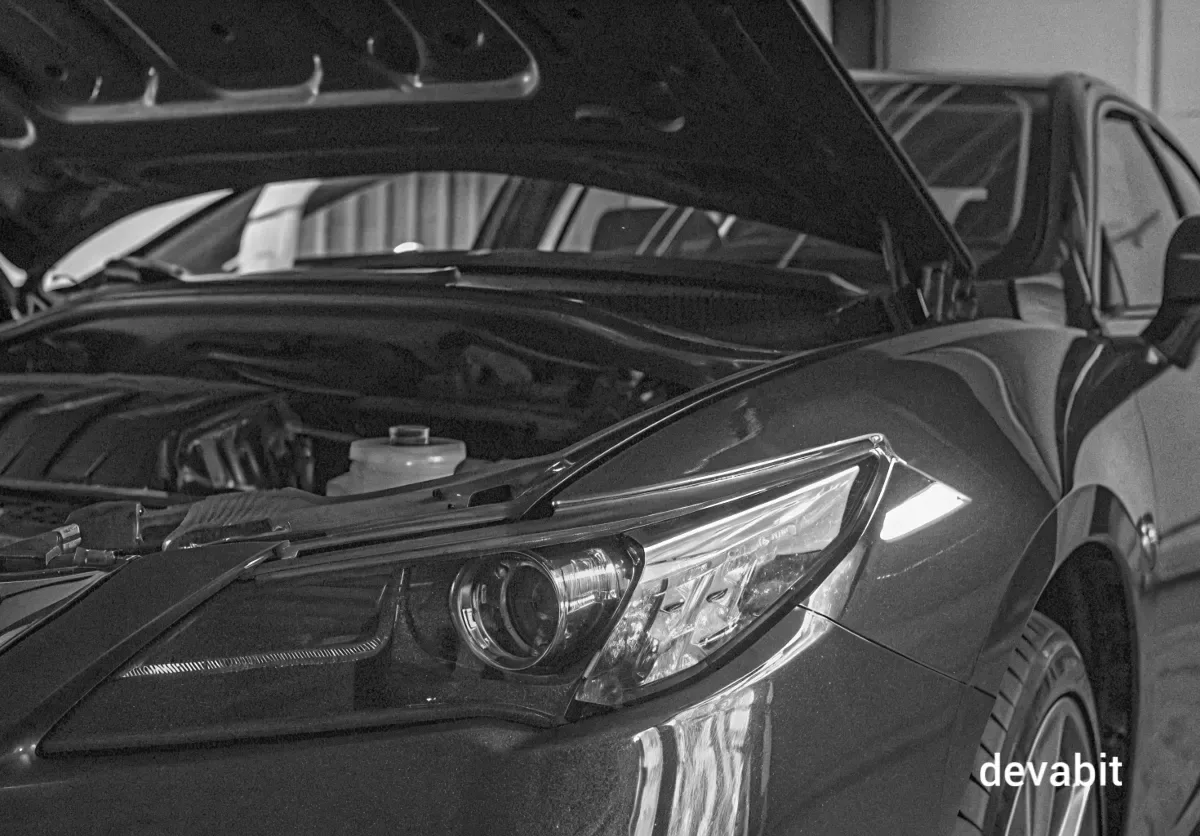
03 / Generative AI & Conversational Interfaces over Maintenance Data
Imagine being able to ask your car what is wrong with it instead of desperately looking at the strange red symbols on the monitor. Now it is our reality! The newest vehicle models are about to be equipped with conversational options, enabling them to analyze the sensor data on their own and generate a quick summary. Just for you not to panic too early, the engine is fine :)
04 / Edge AI Software in Automotive
Edge AI in the automotive industry means running AI models directly inside the vehicle instead og relying on the cloud-based environments. The goal is to make cars safer, faster to react, more private, and less dependent on connectivity. Thanks to Edge AI, smart vehicles can now make instant decisions with zero or minimal latency, leading to safe driving, tailored driving experiences, and data-driven vehicle maintenance.
Predictive Maintenance Automotive: devabit Predicts...
It seems like we have all been there. Standing next to your car that just will not move an inch without any reason at all, while being in the middle of nowhere, and seeing a huge dark cloud racing towards you. Sounds like a pure auto-nightmare. And luckily, predictive maintenance automotive is here to make your worst fears an old, forgotten tale. Predictive and preventive maintenance have become the real Prince Charming for the automotive industry, making vehicle care easier (and cheaper!) than ever before.
It may seem like these new systems want nothing but to make you visit the dealership again and again. But the truth is that predictive maintenance for cars would recommend a few checks and repairs a year, so that you never find yourself next to that moveless car already needing to be thrown away rather than quickly repaired. But what does devabit predict? Needless to say, dealerships operating predictive maintenance, AI technologies, and intelligent algorithms will always be one step ahead of those who still rely on "I heard that strange engine noise a few weeks ago...". devabit, as a leading automotive data management services provider and automotive software developer, recommends you to keep your eyes on poredictive maintenance in the nearest years, cause that thing is about to transform into something next generation would never be amazed by. In order to become tomorrow's leader, you must be today's pioneer. And in case you are currently looking for a trustworthy software development partner or seek some solid consulting services, Contact Us right here and become the pioneer of the automotive world today.
Recent Publications
Don't miss out! Click here to stay in touch.
Discover our Automotive Services

Relevant Articles View all categories
View all categories CONNECT WITH US WE’RE READY
TO TALK OPPORTUNITIES
THANK YOU! WE RECEIVED YOUR MESSAGE.
Sorry
something went wrong



